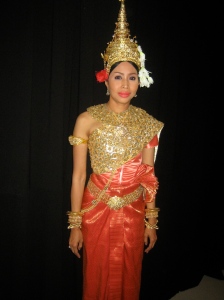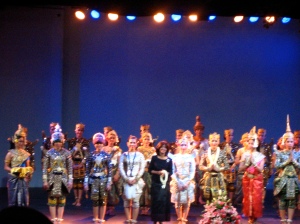In our second week in Phnom Penh, I was in for a few treats. Our cast’s social calendar was filling up with invites to the Royal Ballet by the Princess of Cambodia, and a welcome soiree by the US Ambassador. But what was most exciting to me about this particular week was the sitz probe (or orchestral run-through for you lay-folk).
Him Sophy’s score for Where Elephants Weeps is an amalgamation of traditional Cambodian music, which has a really earthy aboriginal feel, with western rock and hip hop. So we essentially have two orchestras: Our rock band, consisting of all these cutting edge and hip musicians- and our traditional band, who are all the masters of their craft, descendants of great masters with double PhD’s teaching at the Royal Academy, AND equally hip because (this is going to really excite those of you who enjoy your ethnomusicology): We have century-old traditional instruments that have not changed until they’ve recently been taken apart and rebuilt to accommodate Him Sophy’s innovative score. Keo Sonankavei is one such musical master and genius who enhanced the newly and aptly named gong thom chromatique and roneat aik chromatique, as their previous scale configurations did not include half notes.
Being a part of the first time these instruments are heard together in this fashion was completely thrilling for me, and I have to admit I still get giddy every time I get into a room with these guys. I’m lacking in the words to describe the excitement felt by all of us who’ve come together from vastly different background to put forth this story in a way that’s never been told before. I love creating new work.
The other treat that week was getting invited to a performance of Sovhannahong by the Princess of Cambodia. Many of our Cambodian cast and staff are Royal ballet dancers, and non other than our very own ChanMoly was one of the stars that night. The piece was a work originally choreographed by the King’s mother, who had been a dancer, but never finished it. The project was re-commissioned by the Princess in honor of her father the King for his birthday.
I first saw traditional Cambodian dance in a piece called Pamina Devi at the Joyce in New York City. It was honestly like nothing I ever saw and I kept feeling like I wasn’t Getting something about it. What I did get however, was an amazing impression of the lead dancer Setya, who’s precision and amazing expression spoke to me across boundaries. Imagine my utter excitement when I learned I would get to work with her, a year and a half later! The world is very small. During rehearsals, I found out indeed I had missed something- all the traditional movements are shorthand sign language, in a way. There is meaning to every languid flick of the wrist and tilt of the head, curl of the toe. I began to be fascinated with this as we have incorporated many of the moves into the play within our play, and I attempt to bend my body onto these revered gestures. My last bit of feedback was people were happy with me, though I suspect they are just being incredibly kind- the dancers train from childhood to perfect these moves. I’m so grateful I get to work under their guidance, though!




1 Comment (+add yours?)